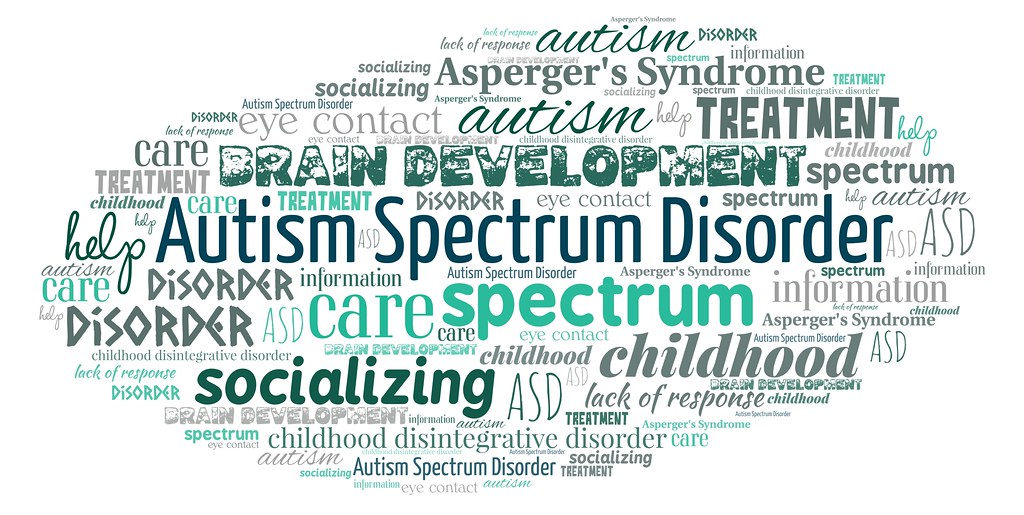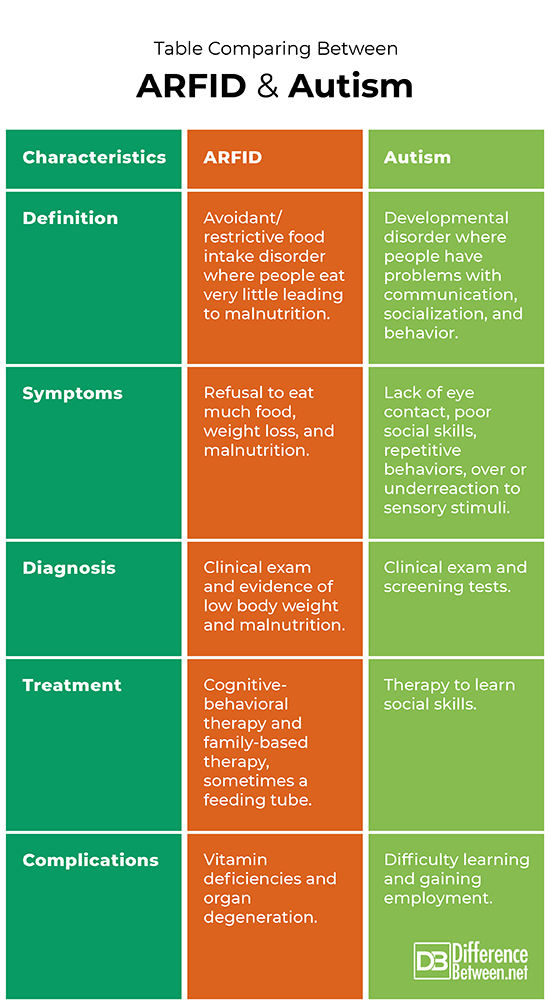Difference Between ARFID and Autism
ARFID is a condition, most often starting in childhood, where people eat very little food resulting in malnutrition. Autism is a developmental issue involving problems in communication, social interactions, and behavior.

What is ARFID?
Definition:
ARFID is avoidant/restrictive food intake disorder in which people eat very small amounts of food with the consequence of malnutrition and low body weight. People usually show signs of ARFID in childhood and they refuse to eat due to not liking textures, colors, or because they are afraid of choking. The lack of eating is not due to a fear of gaining weight.
Symptoms:
People with ARFID will only eat a few types of food and will not try new food items. They often lose a lot of weight and suffer from a lack of nutrients. A child with ARFID does not gain weight the way they should. While many children may be picky eaters, children with ARFID feel distress over eating and may not appear hungry. This is not the case with picky eaters, who do not have anxiety over types of food but are simply fussy, although picky eating can be an early sign of ARFID.
Causes and complications:
The cause of ARFID is not known for certain but is thought to involve psychological factors and can be related to autism where there are sensory problems. Children who grow up with the condition may show a slow heart beat and, in the case of girls, amenorrhea can occur. Severe deficiencies of vitamins can lead to degeneration of organs including of nervous tissue.
Diagnosis and risk factors:
Diagnosis of ARFID is based on the individual showing signs of malnutrition and weight loss. The individual also shows psychological disturbance. A risk factor for ARFID is autism or having intellectual disabilities. Children who have anxiety disorders are also at increased risk of ARFID.
Treatment:
Cognitive-behavioral therapy and family-based therapy can be helpful in treating ARFID as can the use of anti-anxiety medication where a person suffers great anxiety over eating. In cases of severe malnutrition due to refusal to eat, a feeding tube may be necessary to ensure the person gets enough nutrients.

What is Autism?
Definition:
Autism is a developmental disorder where a person has difficulty with social skills, communication, and behavior.
Symptoms:
Autistic people fall on a spectrum, with some having more severe symptoms than others. In general, autism symptoms include having problems with communication and engaging in repetitive behaviors such as hand flapping or spinning. There are often limited interests and autistic people often do not understand social cues including nonverbal behavioral cues, and they may avoid making eye contact. In some cases, an autistic person may become obsessed with a particular subject. They may underreact or overreact to sensory stimuli, including the taste and texture of food, which can cause eating problems. Light and sound can also be overwhelming for some autistic people.
Causes and complications:
The cause of autism is not known although genetic factors such as mutations, are a factor. For instance, individuals with fragile X syndrome (a particular gene mutation) often have autism. Exposure to certain chemicals that are neurotoxic, such as valproic acid, has been implicated as a causative factor of autism. People with autism may find it difficult to obtain employment and they can become socially isolated. Difficulty in communicating can also make learning in school a problem.
Diagnosis and risk factors:
Autism is most often diagnosed before the age of 3 years. Diagnosis is done using screening tests such as the Autism Diagnostic Observation Schedule-2, and by clinical evaluation of the person. Women who have German measles while pregnant are also more likely to have an autistic child. Boys are more likely to have autism as are premature babies and babies born to older women.
Treatment:
Therapy in which autistic children are taught how to behave and how to understand social cues and communicate with others, can help them to function better. However, the success of therapy does depend on how severe the condition is.
Difference between ARFID and Autism
Definition
ARFID is Avoidant/restrictive food intake disorder, which is where people eat very little leading to malnutrition. Autism is a developmental problem where people have problems relating to other people, and in communicating and they have behavior problems.
Symptoms
People with ARFID refuse to eat very much food, they lose weight, and are malnourished. People with autism don’t make eye contact, have problems communicating and interacting with others, and show repetitive behaviors.
Diagnosis
ARFID is diagnosed by clinical exam and noting the low body weight and malnutrition of the person. Autism is diagnosed by clinical exam and screening tests.
Treatment
The treatment of ARFID is often a combination of cognitive-behavioral and family-based therapy. The treatment of autism is often therapy to teach the person how to interact with others.
Complications
Complications of ARFID include organ degeneration and vitamin deficiencies. Complications of autism are problems learning in school and gaining and keeping a job.
Table comparing between ARFID and Autism

Summary of between ARFID Vs. Autism
- ARFID and autism are both conditions most often seen in childhood.
- ARFID is related to autism in that autistic individuals often have sensory problems that can lead to ARFID.
- Both ARFID and autism can be treated with therapy.
- Difference Between Rumination and Regurgitation - June 13, 2024
- Difference Between Pyelectasis and Hydronephrosis - June 4, 2024
- Difference Between Cellulitis and Erysipelas - June 1, 2024
Search DifferenceBetween.net :
Leave a Response
References :
[0]Clemens, Roger. "ARFID: A New Eating Disorder Classification." Food technology 69.9(2015): 21-21.
[1]Sulkes, Stephan Brian. “ Autism Spectrum Disorders” Merckmanuals. Merck & Co., 2020, https://www.msdmanuals.com/professional/pediatrics/learning-and-developmental-disorders/autism-spectrum-disorders
[2]Thomas, Jennifer J., et al. "Avoidant/restrictive food intake disorder: a three-dimensional model of neurobiology with implications for etiology and treatment." Current psychiatry reports 19.8 (2017): 1-9.
[3]Image credit: https://live.staticflickr.com/65535/48479748407_8bf737ab1d_b.jpg
[4]Image credit: https://www.ifemdr.fr/wp-content/uploads/2021/01/dossier-emdr-et-tca.jpg
